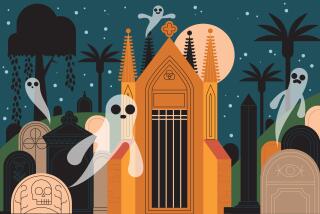Church on the Way Assumes Expenses for Historic Cross
- Share via
VAN NUYS — Calling the Hollywood cross a beacon “greater than the city’s sin,” the large Church on the Way in Van Nuys has taken over the familiar but often-battered landmark, apparently insuring that it will be maintained for years to come.
Since 1923, the lighted cross atop a ridge in Cahuenga Pass--now 33 feet high--has caught the eyes of Hollywood Bowl audiences and commuters traveling to and from the San Fernando Valley on the Hollywood Freeway--at least whenever it wasn’t toppled or darkened by wind, fire, vandalism and church-state legal objections.
It is such a prominent local landmark that it was incorporated into the Los Angeles County seal.
It was reconstructed most recently in 1993 by a shortwave radio evangelism group, the Simi Valley-based High Adventure Ministries, led by George Otis Sr., who had been given the small plot of land where it stands by a Kiwanis Club.
“We rebuilt the cross, using some of the remains of the [original] cross lying on the ground, and putting it onto a concrete base,” said Todd Hacker, controller of High Adventure Ministries.
Otis, who is currently overseas, offered the cross to the 8,900-member Church on the Way, noting in a letter last year to Senior Pastor Jack Hayford that High Adventure had spent $110,000 on the cross’ reconstruction.
“As I said, we aren’t selling the Cross, but we would like to conserve at least a part of the investment we have made in it by making this request,” Otis wrote. “We are hoping for a gift of at least $75,000 so we can erect [a] radio tower in the Middle East.”
The congregation exceeded Hayford’s goal of raising $100,000--coming up with not only a $75,000 donation to High Adventure Ministries but also raising nearly $50,000 for an endowment fund to cover estimated maintenance costs of up to $5,000 a year, said John Farmer, an administrator at Church on the Way.
“We were prepared to give them the cross, because we wanted someone to carry the torch, so to speak,” said High Adventure’s Hacker.
*
Otis sees the cross--which is visible for miles, shining brightly against a dark patch of hillside--as a rebuke to the reputation of the Hollywood area it overlooks, Hacker said. “George felt very passionately about raising a standard against movies and entertainment that pollute the morals of the people.”
Hayford, who was unavailable for comment this week, struck similar notes earlier in seeking money from his congregation, describing the cross as “louder than the freeways’ din, greater than the city’s sin . . . radiating the world’s one abiding hope where pain and loss have brought shame and ruin.”
The Hollywood cross was first erected with much humbler purposes--as a memorial to Christine Wetherell Stevenson, the heiress to the Pittsburgh Paint fortune, who helped arrange the building of the Hollywood Bowl.
In 1920, Stevenson chose 29 acres across from the Bowl for an open-air theater as the setting for “The Pilgrimage Play,” which she had written about Jesus. She died two years later, and admirers planted a cross as a memorial to her on a hill above the theater.
After a fire destroyed that theater, a concrete theater was built in 1931 to revive her play. The theater and the cross were donated in 1941 to Los Angeles County, which eventually renamed the theater after longtime Supervisor John Anson Ford. The cross was incorporated into the official seal of Los Angeles County along with the Hollywood Bowl.
The play ran until 1964 when the first of a series of lawsuits, citing constitutional church-state issues, challenged the county’s sponsorship of the religious theater and production.
A year later, the cross was damaged by fire. The county replaced it with a steel-and-plexiglass structure and routinely lit the cross at Easter. But that governmental support was halted in 1980 by a lawsuit that successfully contended the county violated the 1st Amendment by maintaining the cross at public expense.
The church-state conflict was resolved in 1984 when Marian N. Gibbons, president of Hollywood Heritage, bought the cross’ site from the county.
Meanwhile, the cross, unused and unguarded, was damaged by vandals, and a windstorm knocked it over. Volunteers raised a 17-foot cross on the small plot in 1985, but it wasn’t until 1993 that High Adventure Ministries built the present 33-foot structure.
*
In taking over the cross, marked by a ceremony at its base late last month, elders of the Church on the Way have recommended that other Christian ministries and churches be invited to join the project as a way of countering possible complaints.
“Even though our congregation is fully able to fund it alone,” Hayford reported earlier to congregants, “we believe any future anti-Christian criticism of the cross’ presence can better be answered by a collective voice, rather than just one congregation’s.”
As a result, a board of trustees for the cross endowment fund is being formed with representatives of the Foursquare Gospel denomination, to which Church on the Way belongs, and churches involved in the multiethnic Love L.A. pastors fellowship that is led by Hayford.
More to Read
Sign up for Essential California
The most important California stories and recommendations in your inbox every morning.
You may occasionally receive promotional content from the Los Angeles Times.










